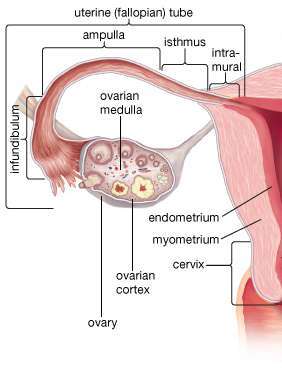Fallopian/Uterine Tube
Definition
Synonyms : fallopian tubes, Uterine tubes, salpinx (pleural : salpinges)
Two very fine tubes that extend laterally from near the fundus towards the ovaries for the purpose of collecting the ovum released by the ovary at the time of ovulation
Structure
Different parts of the tube : infundibulum with fimbrae, ampulla, isthmus that connects the ampulla to the uterus, interstitial part (intramural part that traverses the uterine musculature)
The ostium is the point where the tubal canal meets the peritoneal cavity
Uterine opening is the entrance into the uterine cavity, the uterotubal junction
Four distinct layers:
Serosa - derived from visceral peritoneum
Subserosa - loose adventitious tissue, blood vessels, lymphatics, an outer longitudinal and inner circular smooth muscle coats
Lamina propria - vascular connective tissue
Mucosal layer - the inner most layer of the Fallopian tube (oviduct) has both simple and ciliated columnar epithelium, the latter predominantly
Functions
The fimbriated end Captures the ovum (secondary oocyte) which is released by the ovary.
Transmits the ovum to the ampulla where sperms meet it and fertilize and then the zygote is passed on to the uterine cavity
The peg cells in the tube produce tubular fluid which contains nutrients for spermatozoa, oocytes and zygotes
The secretions of the tube promote capacitation of the sperm by removing glycoproteins and other molecules from the plasma menbrane of the sperm
Tubal fluid flows against the action of the ciliae, that is toward the fimbrial end
Applied Anatomy
Tubal block by infections like gonorrhoe etc leads to infertility
Embedding of the zygote in the tube itself instead of the uterine cavity leads to tubal pregnancy (ectopic pregnancy), consequent rupture of the tube and hemoperitonium, and the serious outcome that follow.
Tubectomy : bilateral tubectomy done to sterilize the patient in family planning
* * * * * * * * * *



